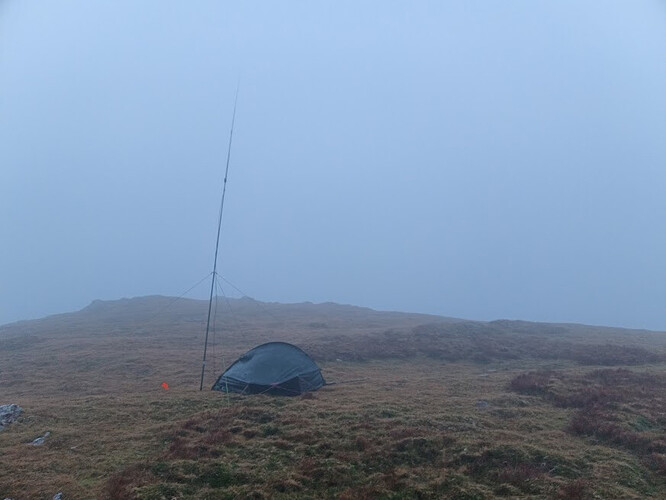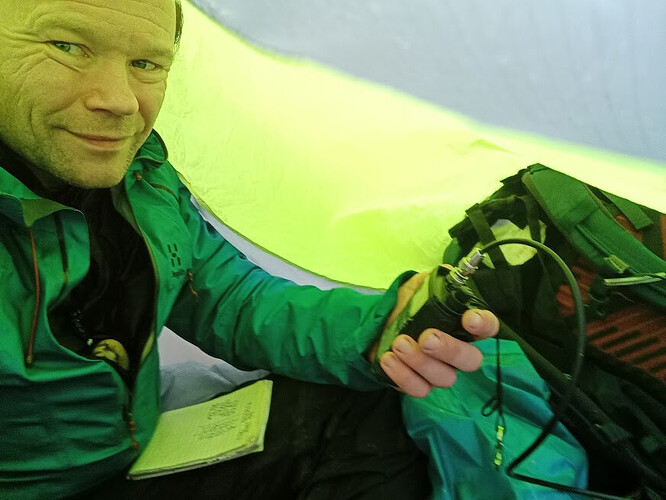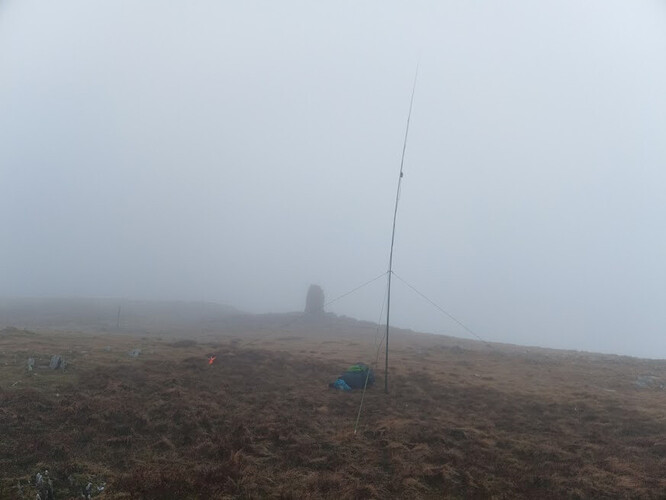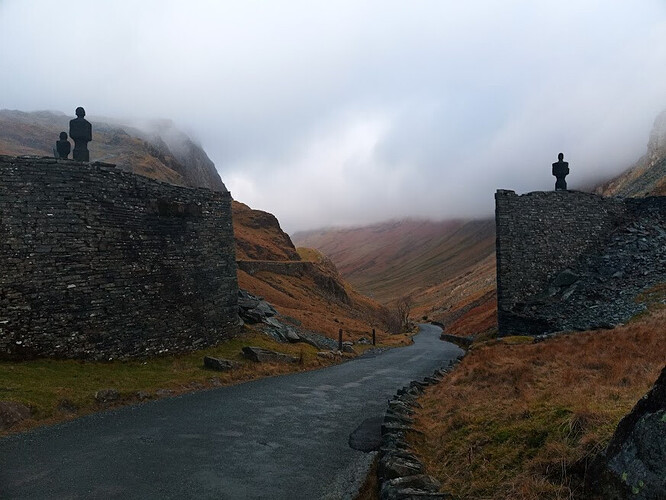Wanting to do a summit top camp in January, I opted for Robinson. With daylight ending around 1700hrs, and needing to cycle across after work, Robinson provides simple navigation and a water source close to the summit. Robinson also offers the opportunity to pitch a tent at a lower altitude on the walk-in (on Buttermere moss) should weather prove less ideal than forecast.
The forecast was for up to 30mph winds on the summit, with no precipitation - although as we shall see it turned out quite wet at times. Temperature was due to to just above freezing. It being January, and not wanting to become stranded on a frozen summit due to an inaccurate forecast, a carried ice-axe and crampons. The extra weight and winter gear, plus the poor night-time conditions on HF recently, meant I opted to stick to 2m
I packed two handheld radios (one of which has APRS), a flowerpot antenna, 7m pole and various batteries and telescopic antennas. I was also looking forward to trying my new bothy bag.
I set off from home a little after 1630 hrs, cycling through the various West Cumbrian villages until reaching Lamplugh, where the route heads off to Loweswater. By this time it was properly dark, and I stopped for snack - raisin and cinnamon bagels. Replenished I whizzed down fangs-brow ( a steep road climb above Loweswater), as I passed the end of Loweswater I could sense the shadow of Mellbreak against the sky - but the night was too dark to see anything much. After a couple of sharp climbs, I was gliding down the side of Crumnock water, beneath Grasmoor (site of a summit camp last spring) - again no view in the darkness.
I opted to lock my bike to the Buttermere road sign at the base of the Newlands pass - a location I had used previously.
After changing into walking gear quickly, and a last check nothing vital was left in my panniers (except for a block of Poundland twin-peaks dark chocolate, ready for my return) I headed off. I light could be seen part-way up the hillside, so I was looking forward to meeting another walker/runner on the way up. It was about 1900hrs when I set off.
The path here is well worn and easy to follow, with a steady gradient - I consoled myself that since the road sits just below the 200m contour I had only a little over 500m to climb.
At around 300m I found the source of the light I had spotted - a couple of tent pitched on the hillside. I continued up, looking back down towards Buttermere village to gauge my elevation gain. This is a pleasant walk in the dark since the path is clear to follow and there are plenty of features to entertain in the darkness.
At 500m elevation the path reached the plateau of Buttermere Moss - suddenly Keswick comes into view. The Moss feels wonderfully wild and remote in the dark. By now there was a steady mist/drissle but the wind was not too string, and I confirmed my decision to camp atop the summit.
On the eastern side of the Buttermere Moss I deviated from the path to collect water at NY 196169. While sitting on the river bank I got to try out my new bothy bag. It is superlight, so I was pleased to find it still works to keep dry and warm. Fully replenished, with an extra 2kg of weight to carry (water for the overnight) I headed up the last section of path to the summit.
The next 100m of climbing is fairly steep in places, with some scree and rocky patches which was all good fun. Occasionally I like to turn off all my lights and stop to admire the darkness. I always have two torches running - a headlight, and a hand torch. Plenty of other backup light sources are in the bag.
I was glad to reach the top of the climb, and begin scouting for camping spots. The one used last year was a bit exposed in the westerly wind, so I found a nice spot on the SE side of the summit around NY202168. It was now about 2040 hrs.
I rapidly got the tent up - a Hilleberg Akto, and began erecting the antenna. Part way through putting up the antenna my hands were getting rather cold so I dived into the tent and started sorting the bedding before going back out to complete the antenna.
The BNC connector was threaded under the tent outer, and with the wind gusting above 30mph, and a steady rain/drissle I was glad to get back into the tent and change into night clothes… Following a bite–to-eat I was ready to radio.
I called CQ just after 2100 hrs, and as pleased to hear a few stations calling. GM4WHA was first - we have a had a few poor signal contacts on summits in January so it was good to get a decent report and be able to wish Geoff happy-new-year. Next was 2E0MIX, followed by G0TDm and 2E0XUP for the fourth contact. 2E0XUP and I had a good chat about cycling before I moved on to make a few more contacts. I was especially pleased with the QSO with 2E0XUp as, not only did I find he also watches the YouTube channel run by Hambini, but it marked me crossing the threshold of 500 activation points, with 354 now in the last rolling twelve months.
It was a busy evening, with lots of stations calling, and plenty taking the time to have a proper talk. Of particular note was 2E0XLG/P who was operating from The Shack in the Dales - an old Royal Observer Core observation point, above Settle. I was also pleased to catch G7SXR in Leeds and 2E0NTO near Accrington. The final QSO was with Sue, G1OHH finishing about 2330 - time for bed.
I put a few calls out in the night, and also listened out occasionally. At 0808 hrs I heard G0TDM calling for me on 145.500, I responded and after a quick chat heard M1EYP/P on G/SP/005. After also talking with GM4WHA and GW8XAS I started dismantling the equipment and tent, before heading off the summit just before 0900hrs. I had intended to leave at about 0800hrs, but had enjoyed the lie-in.
Saturday morning atop Robinson - tent pitched quite low to the ground, and very wet
The route across to Dale head is easy, although thick mist meant there were no views. The summit of Dale Head (G/LD/020) was reached at 0950hrs, and after putting up the antenna I sat inside the bothy bag.
Bothy bag operating on Dale Head
Misty summit
I am really enjoying having a bothy bag for activations - I have never bothered before, as I am usually carrying a tent, so the need for emergency shelter is already covered. However for a quick source of shelter on a windy summit, the bothy bag is great.
I called cq at 0955, and G7CDA was first to respond, followed by G0TDM, GM4WHA and 2E0XUP. I was pleased to get MI6LNP across in Northern Ireland followed by a S2S with 2EOiXM/P on G/SP/004. at 1022 I closed down and headed off the summit.
Out of the mist at last as I descend to Honnister
Since there were no views to be had, I decided to head down to Honnister and road walk to Buttermere. Descending out of the mist was a bit of a relief - with the night-time walking the previous night, and mist this morning, I had seen little of my surroundings since setting off. It was a good decision to drop down, as the valley was clear giving great views of the mountain sides I had been crossing earlier. Also, the valley is littered with lots of large erratic boulders which are always interesting to see. The last time I walked this valley was on the walk home from Helvellyn in January last year.
Road walk to Buttermere
A was glad to get back to the bike, and find it safe and well. After munching on the chocolate I had left, and attaching everything to the rack, I headed off for a steady ride home.





